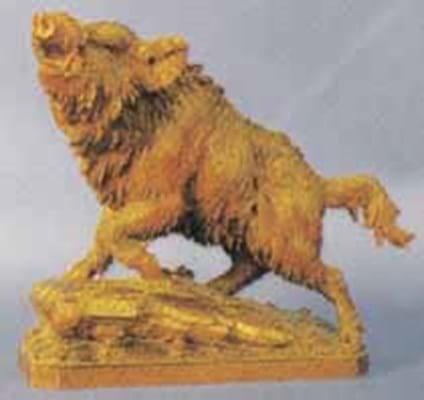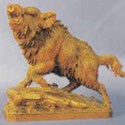The area worst affected by falling demand recently - harder hit even than 19th century furniture - has been routine silverware. This being so, the £500-700 estimate put on a London 1846 four-piece tea service seemed rather ambitious.
Embossed and engraved with floral decoration, it was, however, a very pretty service, said auctioneer Sarah Debnam and, on the day, attracted a lot of interest before selling to a Spanish dealer at £820.
Topping the furniture was a well-carved Victorian walnut and button-upholstered foyer seat. Comprising a shaped circle divided into four seats with central carved walnut and upholstered back rests, this unusual four-seater stood on brass and ceramic casters. Estimated at up to £1500, it sold at £2500 to a local firm whose foyer it will presumably grace.
Also bringing what looked a good price these days - although £100 below the top estimate - was a Victorian figured walnut davenport with a rising top. A private buyer took the rather impractical, but decorative, piece at £1400.
Other solid sellers in a currently difficult market included three pieces of Regency mahogany. A bow-front sideboard with figured reeded top went over hopes at £1650; an ebony line-inlaid sofa table took a lower-estimate £1400 and a drop-leaf work table with rosewood crossbanding made £1200.
What looked a good buy for a private bidder was a Queen Anne walnut chest with a crossbanded moulded top above two short and three long drawers with original brass handles and escutcheons. At 3ft 3 1/2in (1m) wide it was perhaps a little big to be commercial and had undergone some restoration and alteration. This is to be expected of a 300-year-old piece of furniture, but is still a drawback for the selective trade and the private buyer got the chest at a lower-estimate £2000.
Among the works of art the top seller, as expected, was a 12in (30cm) tall bronze of the racehorse Ibrahim signed P.J.Mêne, which went to a Scottish collector at an above-estimate £2400.
A less common offering at a provincial auction was a lot tersely catalogued as a Middle Bronze Age, white-painted ware jug, c.1700BC, and two small plain white juglets. Apparently the sellers could authenticate the jug and the lot took a private bid of £500.
Dealers, however, were determined to secure two of the more unusual offerings.
One was a large Black Forest carving. Not of a bear, whose appeal seems to have plateaued, but of a very well carved boar. Estimated at up to £300, this attracted a lot of pre-sale interest and four telephone bidders took part in the battle which eventually ended in a bid of £1000.
Another unexpected trade target was a Japanese carved bamboo and silver-mounted walking stick with skull handle. Estimated at £80-120, this took £780 from a specialist London dealer.
Old standards sell alongside new fancies
SOME steady selling of material which has been hard to shift of late provided some encouragement for the trade generally at Lawrences of Bletchingley's (12.5 buyer's premium) July 20-22 sale and among the 2000 lots – which totalled nearly £200,000 – there were enough of those quirky offerings which make provincial British auctions the fascinating events they can be.








